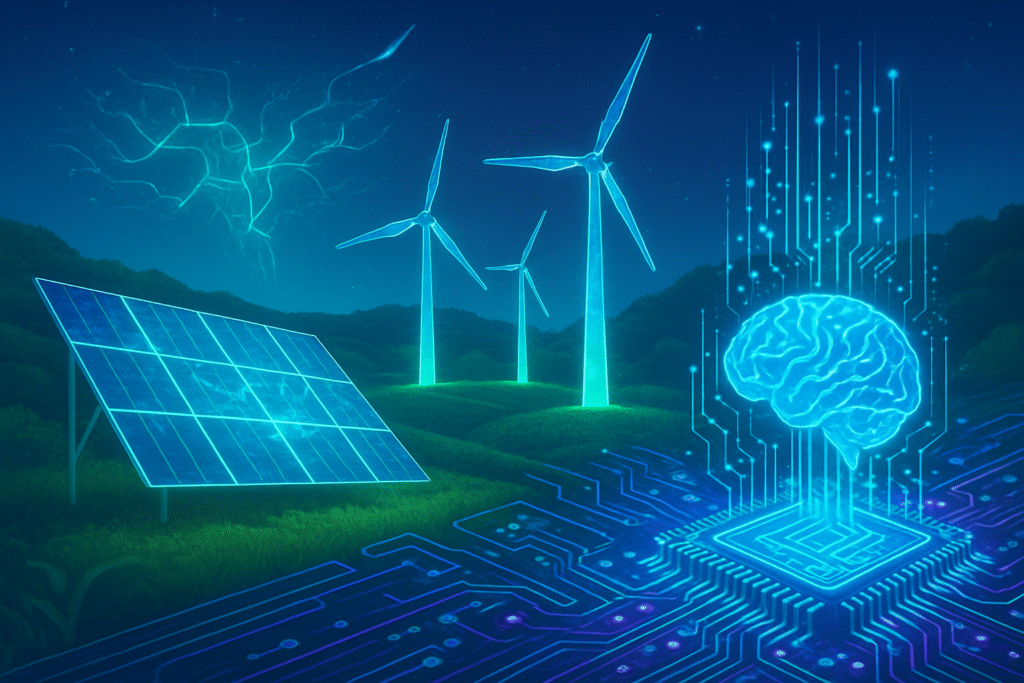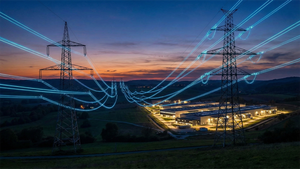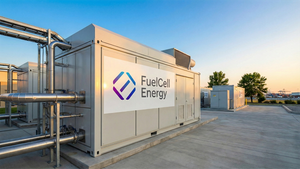
October 22, 2025 – The financial markets of 2025 are witnessing a profound reorientation of investor capital, as the clean energy sector emerges as an undeniable powerhouse, with stocks surging an impressive 44% year-to-date. This remarkable performance stands in stark contrast to, and in many ways overshadows, the robust yet more tempered growth seen in the bellwether semiconductor industry, including giants like Nvidia. The shift signals a pivotal moment where sustainable solutions are not just an ethical choice but a dominant financial imperative, drawing significant investment away from the long-reigning tech darlings.
This dramatic surge in clean energy investments reflects a confluence of escalating global electricity demand, unwavering governmental policy support, and rapid technological advancements that are making renewable sources increasingly cost-competitive. While the artificial intelligence (AI) boom continues to fuel strong demand for semiconductors, the sheer scale and strategic importance of the energy transition are recalibrating market expectations and redefining what constitutes a high-growth sector in the mid-2020s.
The Unprecedented Rise of Green Stocks Amidst Steady Tech Gains
The clean energy sector's performance in 2025 has been nothing short of spectacular. The Invesco Roundhill Clean Energy ETF (PBW) has soared by 44% year-to-date, a clear indicator of broad-based enthusiasm. This momentum is further underscored by the iShares Clean Energy UCITS ETF (INRG), which has appreciated by 42.9% in the six months leading up to October 17, 2025. Individual companies within the sector have delivered even more staggering returns, with SolarEdge Technologies (NASDAQ: SEDG) seeing its stock jump 86% as of August 11, 2025, and Nextracker (NASDAQ: NXT) experiencing a phenomenal 136% year-to-date rise by October 22, 2025. Other standout performers include MP Materials Corp. (NYSE: MP), up 338%, Bloom Energy Corp. (NYSE: BE), soaring 331%, and Amprius Technologies Inc. (NYSE: AMPX), which increased by 308% year-to-date.
These gains are not merely speculative; they are underpinned by fundamental shifts. The clean energy market is maturing beyond a subsidy-dependent model, driven by intrinsic demand and increasing cost competitiveness of renewables. Despite some concerns regarding potential shifts in U.S. policy and the rising cost of financing the net-zero transition, investors are "doubling down on renewables," recognizing the long-term, secular growth trends. The sector is characterized by continuous innovation in areas like utility-scale solar PV, onshore wind, and advanced battery storage, all contributing to its robust outlook.
Meanwhile, the semiconductor sector, while still a formidable force, has seen a more nuanced performance. Nvidia (NASDAQ: NVDA), a titan of the AI revolution, has delivered robust growth, with its stock up approximately 31-35% year-to-date as of October 2025. The company achieved a staggering $4 trillion market capitalization in July, surpassing tech giants Apple and Microsoft. The broader Philadelphia Semiconductor Index (SOX) showed a solid 5.7% return year-to-date as of early 2025. Key individual semiconductor players have also demonstrated strong appreciation, including ACM Research Inc. (NASDAQ: ACMR) up 110%, Advanced Micro Devices (NASDAQ: AMD) up 47%, KLA Corp. (NASDAQ: KLAC) up 45%, and Broadcom (NASDAQ: AVGO) appreciating 47.8% year-to-date. Rambus Inc (NASDAQ: RMBS) stands out with a 116.40% one-year return. Furthermore, Taiwan Semiconductor Manufacturing Company (NYSE: TSM) reported record Q3 2025 results, with profit jumping 39% year-on-year, propelled by insatiable AI chip demand, and its stock surged nearly 48% year-to-date.
Despite these impressive individual performances, the overall market sentiment for the technology and semiconductor sectors in October 2025 appears to be one of "caution," with some bearish trends noted in high-growth tech stocks. This contrasts with the overwhelmingly positive long-term outlook for clean energy, suggesting a significant reallocation of capital. While the long-term demand for AI infrastructure, next-gen chip design, and data center expansion ensures continued growth for semiconductors, the clean energy sector is capturing a larger share of new investment inflows, signaling a strategic pivot by investors towards sustainability.
Realigning Corporate Strategies: Beneficiaries and Competitive Dynamics
The ascendance of clean energy has profound implications for a wide array of companies, from established utilities to innovative startups. Companies deeply embedded in the renewable energy value chain – including solar panel manufacturers, wind turbine producers, battery storage developers, smart grid technology providers, and rare earth material suppliers like MP Materials Corp. (NYSE: MP) – are direct beneficiaries. Traditional energy companies are also increasingly investing in renewable assets, recognizing the inevitable transition and seeking to diversify their portfolios. This creates a competitive environment where agility and commitment to sustainable practices are becoming critical for market leadership.
For AI companies and tech giants, the rise of clean energy presents a dual challenge and opportunity. While the core demand for high-performance chips, driven by AI and cloud computing, remains robust for companies like Nvidia (NASDAQ: NVDA) and TSMC (NYSE: TSM), the broader investment landscape is diversifying. Tech companies are increasingly under pressure to demonstrate their own sustainability efforts, leading to investments in renewable energy to power their data centers and operations. This could foster new partnerships between tech and clean energy firms, or even lead to direct investments by tech giants into renewable energy projects, as they seek to secure clean power sources and meet ESG (Environmental, Social, and Governance) goals.
The competitive implications are significant. While semiconductors are indispensable for the digital economy, the sheer scale of investment required for the global energy transition means that clean energy companies are now competing for, and securing, a larger slice of the investment pie. This doesn't necessarily disrupt existing tech products or services but rather shifts the focus of new capital allocation. Market positioning is evolving, with companies demonstrating strong environmental credentials gaining a strategic advantage. This dynamic could compel tech companies to further integrate sustainability into their core business models, potentially leading to innovations in energy-efficient AI and green computing.
The Broader Canvas: Sustainability as a Macroeconomic Driver
The dramatic shift in investor focus towards clean energy in 2025 is more than just a market trend; it's a reflection of a fundamental reorientation within the broader global economy. This development is intrinsically linked to macro trends such as energy security, climate change mitigation, and the increasing demand for sustainable infrastructure. The imperative for energy security, particularly in a volatile geopolitical landscape, continues to propel renewable energy to the forefront of national agendas, fostering innovation and setting the stage for prolonged growth.
This period can be compared to previous market shifts where a new technology or sector gained widespread acceptance and investment, such as the internet boom of the late 1990s or the early days of personal computing. However, the current clean energy surge feels more fundamentally driven, supported by global policy targets, technological maturity, and a palpable societal urgency to address climate change. The impacts are far-reaching: a rebalancing of economic power, significant job creation in green sectors, and a reduction in reliance on fossil fuels.
While the enthusiasm for clean energy is largely positive, potential concerns include the ability of existing infrastructure to integrate a rapidly expanding renewable grid, and the aforementioned rising costs of financing the net-zero transition. There's also the perennial question of whether any rapidly appreciating sector could be susceptible to overvaluation. However, the current consensus suggests that the growth drivers are robust and long-term, mitigating immediate bubble fears. The demand for expertise in AI, machine learning, and cloud technologies also continues to create new opportunities, underscoring that while clean energy is ascendant, technological innovation remains a critical growth sector.
The Horizon Ahead: Sustained Growth and Converging Technologies
Looking ahead, the trajectory for both clean energy and the semiconductor industry appears set for continued, albeit potentially divergent, growth. Global investment in the energy transition reached a new high of USD 2.1 trillion in 2024, and annual clean energy investment is projected to rise to USD 4.5 trillion by 2030 to achieve net-zero pathways. This underscores the massive opportunities and sustained capital inflows expected in the clean energy sector. We can anticipate further advancements in utility-scale and small-scale solar PV, onshore wind, and particularly in battery storage technologies, which are crucial for grid stability and energy independence.
For the semiconductor sector, the relentless demand for AI infrastructure, advanced computing, and data center expansion will continue to drive innovation. Experts predict ongoing advancements in next-gen chip design, specialized AI accelerators, and quantum computing components. The memory spot market, in particular, is bullish, with expectations of continued price hikes. Challenges for this sector include ensuring sufficient manufacturing capacity, navigating complex global supply chains, and addressing geopolitical tensions that impact chip production and trade.
The convergence of these two powerful trends – clean energy and AI – is also a significant area for future development. AI will play an increasingly vital role in optimizing renewable energy grids, predicting energy demand, managing battery storage, and enhancing the efficiency of clean energy generation. Conversely, the push for sustainable operations will drive AI and tech companies to innovate in energy-efficient hardware and software. Experts predict that both sectors will continue to be critical engines of economic growth, with clean energy potentially leading in terms of relative growth acceleration in the coming years.
A New Era of Investment: Sustainability and Innovation Drive Market Evolution
The year 2025 marks a definitive moment in financial history, characterized by the remarkable outperformance of clean energy stocks and a discernible shift in investor priorities. While Nvidia (NASDAQ: NVDA) and the broader semiconductor sector continue their impressive growth trajectory, fueled by the insatiable demand for AI, the clean energy sector's 44% year-to-date surge signals a broader market re-evaluation. Investors are increasingly recognizing the long-term growth potential and strategic importance of sustainable energy solutions, leading to substantial capital reallocation.
This development signifies more than just a sector rotation; it represents a fundamental acknowledgement of sustainability as a core driver of economic value. The confluence of technological innovation, supportive policies, and global demand for cleaner energy sources has propelled clean energy companies into the forefront of investment opportunities. Simultaneously, the enduring power of AI and cloud computing ensures that the semiconductor industry remains a critical, albeit mature, growth engine.
In the coming weeks and months, market watchers will be keen to observe several key indicators: the stability of clean energy policies globally, further technological breakthroughs in both renewable energy and advanced chip manufacturing, and the continued integration of AI into energy management systems. This dual-engine approach, driven by both sustainability and cutting-edge innovation, is shaping a new era of market evolution, where environmental responsibility and technological prowess are not mutually exclusive but deeply intertwined paths to prosperity.
This content is intended for informational purposes only and represents analysis of current AI developments.
TokenRing AI delivers enterprise-grade solutions for multi-agent AI workflow orchestration, AI-powered development tools, and seamless remote collaboration platforms.
For more information, visit https://www.tokenring.ai/.





